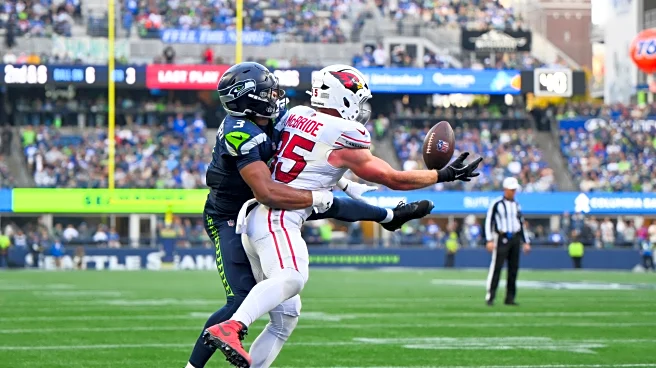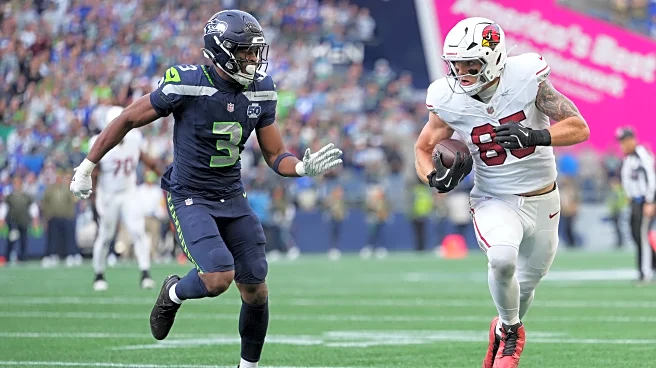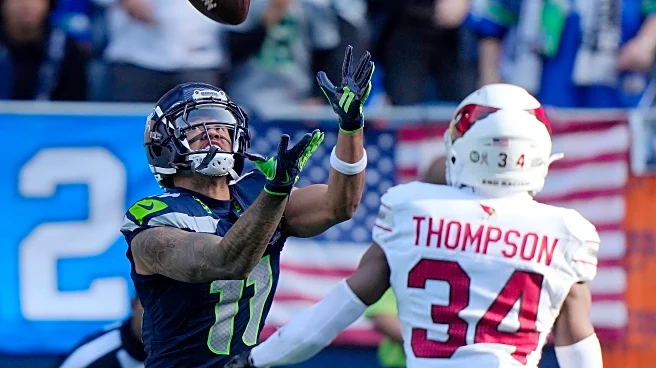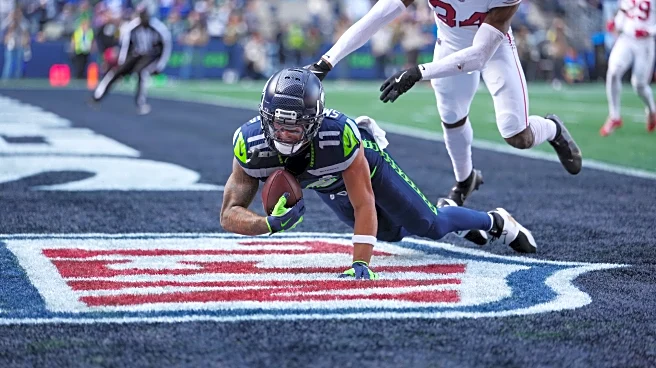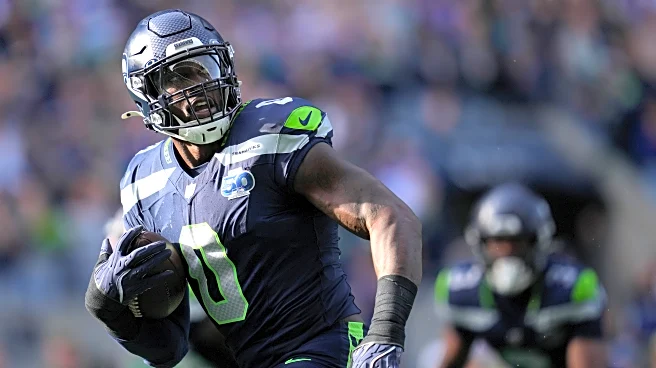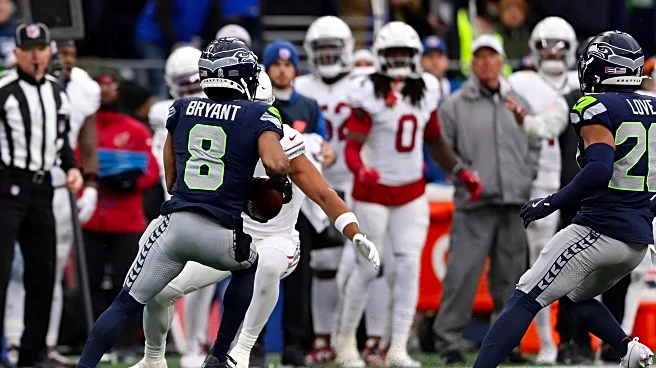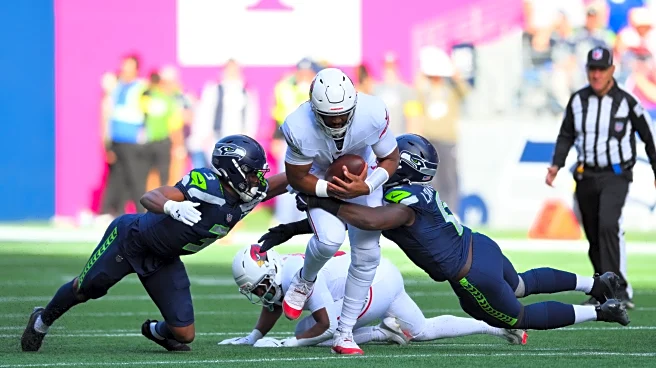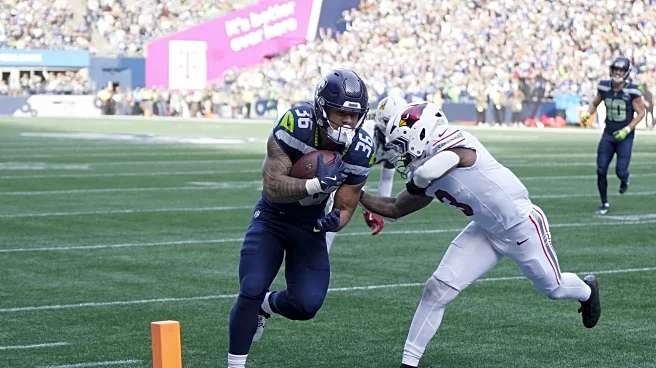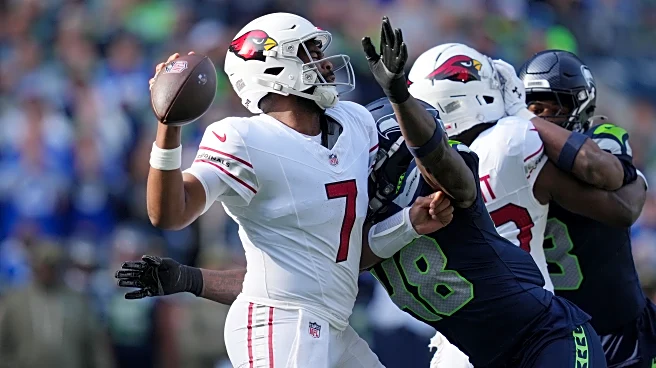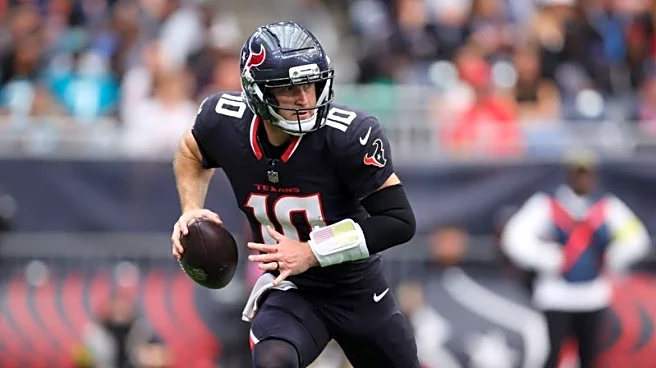The Seattle Seahawks rookies combined for 233 snaps in Week 10 against the Arizona Cardinals. That was the most so far this season, even with Tory Horton not playing. This includes snaps from some players not listed in this article such as Ricky White III (6) and Connor O’Toole (3). All data used in this article was taken from PFF.
Let’s analyze some of the key plays from this game!
Grey Zabel, Offensive Guard (62 snaps)
According to PFF’s ratings, again, the grades were quite contrasting. He had the worst run block score with 45.7 and
was the second-worst offensive lineman in pass block grade with 68.6 even without giving up any pressure (again).
His game still needs improvement, although what catches my attention when watching his tape is that he recovers very well from his mistakes and rarely repeats the same problems. This is fundamental for the development of a rookie.
Another recurring problem, and one that is widespread in the Seahawks’ offensive line, is the inability to create space through brute force. His angle is good, but he can’t get his hands well positioned to move the defensive lineman.
In this game, he showed all his ability at the second level. Good initial contact moving Calais Campbell and helping Charles Cross, then he advances to the second level and blocks the linebacker well.
Almost perfection in this reach block that is a key for zone scheme. It takes speed and a good angle for success, and Zabel achieves it here.
Walter Nolen had a fantastic debut against the Dallas Cowboys. However, the duel against Zabel was favorable for the Seahawks rookie. He executes a good double-team and then finishes the play with the defender on the ground.
My favorite snap of his in the game. He moves to the left and the DT attacks the innermost gap. Excellent recovery ability, moving quickly to get ahead of the defender.
Nick Emmanwori, Defensive Back(70 snaps)
He got nine tackles, his first sack, and no less than four passes defended. His alignment was:
- 4 snaps as DL (basically at the line of scrimmage);
- 19 in the box;
- 3 as a free safety;
- 43 in the slot;
First, let’s address the problems.
His work in off-coverage is one of the areas that needs the most refinement. The Seahawks are in man coverage, and Emmanwori wants to take the inside leverage, since he knows he has no help. He takes a moment longer to cut, and that’s enough for the pass to be completed. It was a beautiful pass, and Emmanwori’s work wasn’t terrible, but it can improve.
My main concern when they transitioned him to nickel was his ability to cover slot receivers in 1v1 situations due his lack of change of direction. Here, it’s just one more step he takes compared to Marvin Harrison Jr, and if the pass/reception were better, it would have been a conversion. It’s worth noting that he had some good snaps in this situation, showing more patience, something that will improve with experience.
In this snap, we have positive and negative points. He loses the release right at the line of scrimmage and even stumbles. The Cardinals call a Mesh concept that creates traffic and makes it even more difficult for the rookie, but he shows all his athletic potential and takes a good angle to make the tackle.
I can’t say for sure, but the Seahawks seem to be in Cover-3 here. With Coby Bryant’s movement, I believe Emmanwori had the assignment, of what was called in the Carroll era, a Soft-Sky. A man-match that has a seam alert that Emmanwori seems to miss. In fact, it was a better option than the pass that was attempted.
Coby Bryant is making a pre-snap adjustment and the rookie doesn’t seem to be on the same page. Furthermore, he takes a long time to notice the run and the safety behind him manages to get there first to make the tackle.
Snag Concept on the part of the Cardinals’ offense. Emmanwori is very physical, just like he was against Zach Ertz in the last game, but so is Trey McBride. And he contests the ball aggressively, preventing the TD.
Another Snag Concept from the Cardinals. Here he demonstrates patience and processing ability, a very encouraging snap. Basically, there are two threats close to Nick, the RB and the WR Michael Wilson (No. 14). If he rushes and attacks one of the routes, the other would be open. Emmanwori remains patient and could defend both routes from the position he was in.
I believe that he and Drake Thomas were funneling the RB. This means that if the release goes towards Thomas, he would be responsible for the coverage, but, as it went towards Emmanwori, he takes over. He does a good job not losing track of the RB when the offense goes into scramble mode, and this pass was much more likely to be intercepted than completed.
Finally, his first sack happened! The Seahawks seem to be in some kind of variation of Sting Coverage. This is a simulated 3-deep, 4-under pressure play from Vic Fangio Tree. The defensive tackles attack the innermost gap to balance the defensive line. Emmanwori shows all his speed, is blocked by the running back, escapes, and gets the sack. DeMarcus Lawrence’s work is noteworthy; he easily gets past the block of Evan Brown, a former Seahawk.
Elijah Arroyo, Tight End (29 snaps)
A very discreet game. Only 1 target, 1 reception and 5 yards. In blocking he showed some improvement and the usual willpower/disposition to block, earning him some good blocks, but he only needs to improve his technique to avoid some errors that occur frequently.
Jalen Milroe, Quarterback (0 snaps)
Inactive.
Rylie Mills, Defensive Lineman (0 snaps)
NFI List.
Tory Horton, Wide Receiver (0 snaps)
Injured.
Robbie Ouzts, Fullback (27 snaps)
Many snaps on the field and managed efficient blocks. When the offensive line reaches a satisfactory level of run blocking, his work will receive even more recognition.
The Seahawks rely on leaving the EDGE open for the FB’s cutblock, which this time he executes masterfully. He committed a penalty against the Commanders on that type of block and missed the target against the Cardinals on another snap.
This is an example of when I say that when the offensive line improves in the running game, the fullback will stand out more. Ouzts blocks the edge again and basically doesn’t give up any space. If the rest of the blocks were well executed, the gap would be there for the running back.
Same drive as the previous play, the Seahawks put the fullback to block the edge on the backside. Again, no ground is lost on the play.
I believe that Olu Oluwatimi missing the snap early on influenced Zach Charbonnet’s read, but he loses space on the right side of the line. The fullback blocks the edge and manages to impose a physicality that the Seahawks’ offensive line often lacks.
Bryce Cabeldue, Offensive Lineman (6 snaps)
I confess that I didn’t understand the decision to take snaps away from Olu Oluwatimi, even though it was at the end of the game. But Cabeldue was tested as a center. After missing the first snap, he managed a good block in the double-team. Cabeldue never played center, he was only an OT in Kansas, but he would be a good center project. He would combine the athleticism and scheme fit of Jalen Sundell and the good angles of Oluwatimi. The question is how he would adapt to yet another position change.
Mason Richman, Offensive Lineman (0 snaps)
Inactive.
Nick Kallerup, Tight End (30 snaps)
He had more snaps than AJ Barner and Elijah Arroyo. In fact, he was ninth in offensive snaps. Acting as Eric Saubert’s substitute, he was basically used for blocking. He even had a target in the red zone on a play that Sam Darnold improvised, but he couldn’t complete the reception. Furthermore, he committed a hold against Calais Campbell that nullified a great run by Ken Walker.
Nick Kallerup simply displaying his physicality and leaving the defender on the ground.
Lining up against an EDGE and taking him out of the play. You can’t ask for much more from a TE.
Good blocking ability creating the gap for Walker’s run. Gives the defender no chance.
Final Thoughts
Grey Zabel had another promising game, and Nick Emmanwori, despite some inconsistencies, played an excellent game. Ouzts and Kallerup were very helpful in the run game. The class isn’t fully complete yet, but its potential is extremely promising.
